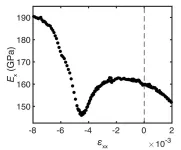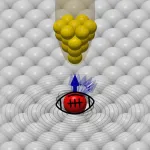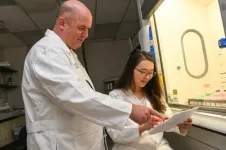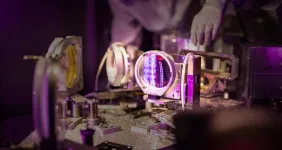(Press-News.org) Semiconductors—most notably, silicon—underpin the computers, cellphones, and other electronic devices that power our daily lives, including the device on which you are reading this article. As ubiquitous as semiconductors have become, they come with limitations. The atomic structure of any material vibrates, which creates quantum particles called phonons. Phonons in turn cause the particles—either electrons or electron-hole pairs called excitons—that carry energy and information around electronic devices to scatter in a matter of nanometers and femtoseconds. This means that energy is lost in the form of heat, and that information transfer has a speed limit.
The search is on for better options. Writing in Science, a team of chemists at Columbia University led by Jack Tulyag, a PhD student working with chemistry professor Milan Delor, describes the fastest and most efficient semiconductor yet: a superatomic material called Re6Se8Cl2.
Rather than scattering when they come into contact with phonons, excitons in Re6Se8Cl2 actually bind with phonons to create new quasiparticles called acoustic exciton-polarons. Although polarons are found in many materials, those in Re6Se8Cl2 have a special property: they are capable of ballistic, or scatter-free, flow. This ballistic behavior could mean faster and more efficient devices one day.
In experiments run by the team, acoustic exciton-polarons in Re6Se8Cl2 moved fast—twice as fast as electrons in silicon—and crossed several microns of the sample in less than a nanosecond. Given that polarons can last for about 11 nanoseconds, the team thinks the exciton-polarons could cover more than 25 micrometers at a time. And because these quasiparticles are controlled by light rather than an electrical current and gating, processing speeds in theoretical devices have the potential to reach femtoseconds—six orders of magnitude faster than the nanoseconds achievable in current Gigahertz electronics. All at room temperature.
“In terms of energy transport, Re6Se8Cl2 is the best semiconductor that we know of, at least so far,” Delor said.
A Quantum Version of the Tortoise and the Hare
Re6Se8Cl2 is a superatomic semiconductor created in the lab of collaborator Xavier Roy. Superatoms are clusters of atoms bound together that behave like one big atom, but with different properties than the elements used to build them. Synthesizing superatoms is a specialty of the Roy lab, and they are a main focus of Columbia’s NSF-funded Material Research Science and Engineering Center on Precision Assembled Quantum Materials. Delor is interested in controlling and manipulating the transport of energy through superatoms and other unique materials developed at Columbia. To do this, the team builds super-resolution imaging tools that can capture particles moving at ultrasmall, ultrafast scales.
When Tulyag first brought Re6Se8Cl2 into the lab, it wasn’t to search for a new and improved semiconductor—it was to test the resolution of the lab’s microscopes with a material that, in principle, shouldn’t have conducted much of anything. “It was the opposite of what we expected,” said Delor. “Instead of the slow movement we expected, we saw the fastest thing we’ve ever seen.”
Tulyag and his peers in the Delor group spent the next two years working to pinpoint why Re6Se8Cl2 showed such remarkable behavior, including developing an advanced microscope with extreme spatial and temporal resolution that can directly image polarons as they form and move through the material. Theoretical chemist Petra Shih, a PhD student working in Timothy Berkelbach’s group, also developed a quantum mechanical model that provides an explanation for the observations.
The new quasiparticles are fast, but, counterintuitively, they accomplish that speed by pacing themselves—a bit like the story of the tortoise and the hare, Delor explained. What makes silicon a desirable semiconductor is that electrons can move through it very quickly, but like the proverbial hare, they bounce around too much and don’t actually make it very far, very fast in the end. Excitons in Re6Se8Cl2 are, comparatively, very slow, but it’s precisely because they are so slow that they are able to meet and pair up with equally slow-moving acoustic phonons. The resulting quasiparticles are “heavy” and, like the tortoise, advance slowly but steadily along. Unimpeded by other phonons along the way, acoustic exciton-polarons in Re6Se8Cl2 ultimately move faster than electrons in silicon.
The Semiconductor Search Continues
Like many of the emerging quantum materials being explored at Columbia, Re6Se8Cl2 can be peeled into atom-thin sheets, a feature that means they can potentially be combined with other similar materials in the search for additional unique properties. Re6Se8Cl2, however, is unlikely to ever make its way into a commercial product—the first element in the molecule, Rhenium, is one of the rarest on earth and extremely expensive as a result.
But with the new theory from the Berkelbach group in hand along with the advanced imaging technique that Tulyag and the Delor group developed to directly track the formation and movement of polarons in the first place, the team is ready to see if there are other superatomic contenders capable of beating Re6Se8Cl2’’s speed record.
“This is the only material that anyone has seen sustained room-temperature ballistic exciton transport in. But we can now start to predict what other materials might be capable of this behavior that we just haven’t considered before,” said Delor. “There is a whole family of superatomic and other 2D semiconductor materials out there with properties favorable for acoustic polaron formation.”
END
A superatomic semiconductor sets a speed record
Columbia chemists discover ballistic flow in a quantum material. The finding could help overcome shortcomings in semiconductors
2023-10-26
ELSE PRESS RELEASES FROM THIS DATE:
Uncovered in Uganda: Evidence for menopause in wild chimpanzees
2023-10-26
To date, research has suggested that only humans and some species of toothed whales live many years of active life after the loss of reproductive ability. But now, a new study shows female chimpanzees in Uganda show signs of menopause – surviving long past the end of their ability to reproduce. Signs of menopause in wild chimpanzees may provide insights into the evolution of this rare trait in humans. The vast majority of mammals stay fertile until the very ends of their lives, with humans and several species of toothed whales as the outliers; they experience menopause. In humans, menopause ...
A new “species” of legal subject: AI-led corporate entities, requiring interspecific legal frameworks
2023-10-26
For the first time in human history, say Daniel Gervais and John Nay in a Policy Forum, nonhuman entities that are not directed by humans – such as artificial intelligence (AI)-operated corporations – should enter the legal system as a new “species” of legal subject. AI has evolved to the point where it could function as a legal subject with rights and obligations, say the authors. As such, before the issue becomes too complex and difficult to disentangle, “interspecific” legal frameworks need to be developed by which AI can be treated as legal subjects, they write. Until now, the legal system has been univocal ...
Special Issue: The hypothalamus
2023-10-26
While small, the hypothalamus – a complex structure located deep in the brain – plays a gargantuan role in coordinating the wide array of neuronal signals that are responsible for keeping the body in a stable state. In a Special Issue of Science, authors across four Reviews unpack this key brain region’s impact on physiological and behavioral homeostasis.
The hypothalamus consists of a complex collection of neural circuits. These circuits receive, process, and integrate sensory inputs to drive coordinated communication via a range of behavioral, ...
A safer alternative to CRISPR-Cas approaches?: Retroelement-based genome editing tools
2023-10-26
In a Perspective, Stephen Tang and Samuel Sternberg discuss retroelement-based gene editing as a safer alternative to CRISPR-Cas approaches. Precision genome editing technologies have transformed modern biology. Capabilities for programable DNA targeting have improved rapidly, largely due to the development of bacterial RNA-guided CRISPR-Cas systems, which allow precise cleavage of target DNA sequences. However, CRISPR-Cas9 systems generate a DNA double strand break (DSB), which activates cellular DNA repair pathways that can lead to unwanted and complex byproducts, ...
UCLA researcher finds first proof of menopause in wild chimpanzees
2023-10-26
Key takeaways
Female chimpanzees in Uganda’s Ngogo community experienced a menopausal transition similar to women.
Fertility among chimpanzees studied declined after age 30, and no births were observed after age 50.
The data can help researchers better understand why menopause and post-fertile survival occur in nature and how it evolved in the human species.
A team of researchers studying the Ngogo community of wild chimpanzees in western Uganda’s Kibale National Park for two decades has published a report in Science showing that females in this population can ...
Conduction electrons drive giant, nonlinear elastic response in Sr2RuO4
2023-10-26
The hardness of materials is determined by the strength of the chemical bonds that are formed between the electrons of the neighbouring atoms. For example, the bonds in diamond are very strong, so it is one of the hardest materials known. The bonding is rooted in the laws of quantum mechanics, and the complex compounds that are of most interest in forefront research today are known as ‘quantum materials.’ In many quantum materials, layers of strongly bonded atoms separate layers in ...
New quantum effect demonstrated for the first time: Spinaron, a rugby in a ball pit
2023-10-26
Extreme conditions prevail in the Würzburg laboratory of experimental physicists Professor Matthias Bode and Dr. Artem Odobesko. Affiliated with the Cluster of Excellence ct.qmat, a collaboration between JMU Würzburg and TU Dresden, these visionaries are setting new milestones in quantum research. Their latest endeavor is unveiling the spinaron effect. They strategically placed individual cobalt atoms onto a copper surface, brought the temperature down to 1.4 Kelvin (–271.75° Celsius), and then subjected them to a powerful external magnetic field. “The magnet we use costs half a million euros. It’s not something that’s widely available,” explains ...
Researchers identify amino acid that may play a key role for predicting and treating long COVID
2023-10-26
University of Alberta researchers have identified an amino acid that may play a key role in predicting poor clinical outcomes and the treatment of long COVID.
In research published today in Cell Reports Medicine, the team says it has developed a predictive test to determine which patients with COVID-19 will go on to develop longer-term symptoms and proposes a clinical trial of an already-approved supplement as a potential treatment.
“This research helps us understand what’s happening in the bodies of people ...
UTHealth Houston researchers awarded $3.4M NIH grant to study pharmaceutical therapies to treat acute respiratory distress syndrome
2023-10-26
A four-year, $3.4 million grant to investigate molecular mechanisms and therapeutic treatments for acute respiratory distress syndrome (ARDS) has been awarded to UTHealth Houston researchers by the National Heart, Lung, and Blood Institute, part of the National Institutes of Health.
The study led by principal investigators Holger Eltzschig, MD, PhD, professor and chair of the Department of Anesthesiology, Critical Care and Pain Medicine at McGovern Medical School at UTHealth Houston, and Xiaoyi Yuan, PhD, assistant professor in the department, is built on many years of research in the endogenous ...
Renewed support for high power laser facilities will benefit discovery science and inertial fusion energy research at SLAC
2023-10-26
Research and technology development for plasma physics and fusion energy at the Department of Energy’s SLAC National Accelerator Laboratory just got a boost from a LaserNetUS award.
In total, the DOE’s Office of Science awarded $28.5 million to advance discovery science and inertial fusion energy, including a three-year grant for the development and operations of the Matter in Extreme Conditions (MEC) instrument at SLAC’s Linac Coherent Light Source (LCLS).
MEC has been home to high intensity laser experiments since 2012, and joined ...
LAST 30 PRESS RELEASES:
Making lighter work of calculating fluid and heat flow
Normalizing blood sugar can halve heart attack risk
Lowering blood sugar cuts heart attack risk in people with prediabetes
Study links genetic variants to risk of blinding eye disease in premature infants
Non-opioid ‘pain sponge’ therapy halts cartilage degeneration and relieves chronic pain
AI can pick up cultural values by mimicking how kids learn
China’s ecological redlines offer fast track to 30 x 30 global conservation goal
Invisible indoor threats: emerging household contaminants and their growing risks to human health
Adding antibody treatment to chemo boosts outcomes for children with rare cancer
Germline pathogenic variants among women without a history of breast cancer
Tanning beds triple melanoma risk, potentially causing broad DNA damage
Unique bond identified as key to viral infection speed
Indoor tanning makes youthful skin much older on a genetic level
Mouse model sheds new light on the causes and potential solutions to human GI problems linked to muscular dystrophy
The Journal of Nuclear Medicine ahead-of-print tip sheet: December 12, 2025
Smarter tools for peering into the microscopic world
Applications open for funding to conduct research in the Kinsey Institute archives
Global measure underestimates the severity of food insecurity
Child survivors of critical illness are missing out on timely follow up care
Risk-based vs annual breast cancer screening / the WISDOM randomized clinical trial
University of Toronto launches Electric Vehicle Innovation Ontario to accelerate advanced EV technologies and build Canada’s innovation advantage
Early relapse predicts poor outcomes in aggressive blood cancer
American College of Lifestyle Medicine applauds two CMS models aligned with lifestyle medicine practice and reimbursement
Clinical trial finds cannabis use not a barrier to quitting nicotine vaping
Supplemental nutrition assistance program policies and food insecurity
Switching immune cells to “night mode” could limit damage after a heart attack, study suggests
URI-based Global RIghts Project report spotlights continued troubling trends in worldwide inhumane treatment
Neutrophils are less aggressive at night, explaining why nighttime heart attacks cause less damage than daytime events
Menopausal hormone therapy may not pose breast cancer risk for women with BRCA mutations
Mobile health tool may improve quality of life for adolescent and young adult breast cancer survivors
[Press-News.org] A superatomic semiconductor sets a speed recordColumbia chemists discover ballistic flow in a quantum material. The finding could help overcome shortcomings in semiconductors




